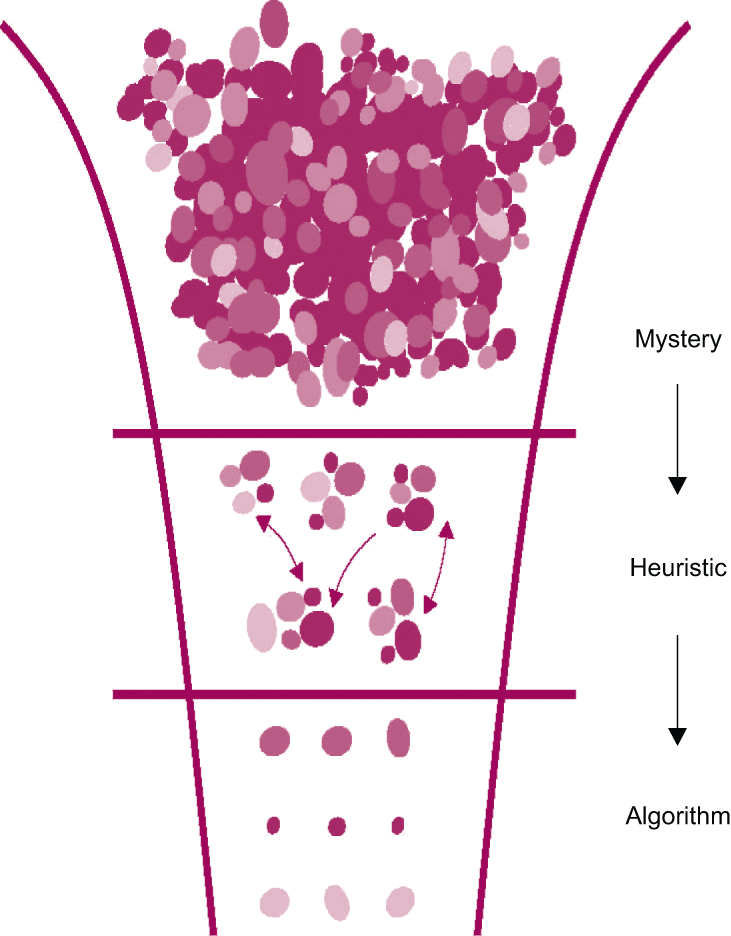The Knowledge Funnel
In his Design Thinking lecture, Martin discussed what he calls The Knowledge Funnel. According to him, the advancement of knowledge travels from a mystery, to a heuristic (a premise stated as a learning tool) to an algorithm (explanation of the truth, more or less proven by being replicable).
Martin's example is a classic one: gravity. At first, we didn't understand how or why objects fell to the ground when we dropped them, some faster than others. It was a mystery. Then, as Newton sat under the apple tree and was bonked on the head, he concluded that objects were drawn to each other in relation to mass. As a heuristic, he determined that mass would differentiate the velocity of falling objects, and that he would be able to repeat this phenomenon. Through experimentation, he arrived at an algorithm which would become the law of gravity. He had to imagine it before he could prove it. Imagination is always necessary for advancing to the next stage of the knowledge funnel.

Under another proverbial tree, Buddha sat, contemplating the causes of human suffering and the Eightfold path. He determined that all truth could be arrived at through exploration of the inner self, and that all of the scriptural text he had studied up unto that point was useless.
Just as Charles Sanders Pierce determined that no new idea could be arrived at solely from adherence to existing data.
The progression from mystery to heuristic to algorithm requires a forward leap in logic. One must guess. One must be Intuitive.
Corporations all over the world, both big and small, have achieved staggering success by having a little faith and making leaps in logic. Steve Jobs was famous for integrating aggressive market research with brilliant intuition. Martin cites Subway for actually overtaking McDonald's in size by guessing that customers would prefer fresh, non-greasy foods over pre-packaged burgers.
But in order to achieve these heights, Intuitive and Analytical thinkers need each other. The trick is learning how to work together.
Innovation, What's it For?
Why is innovation important? It is not an arbitrary virtue. As Roger Martin asserts, innovation is important because it makes us more efficient.
Why is efficiency important? Efficiency means we can spend less time on things we need, and more time on things we want. Over time, the things we want become the things we need, on both a personal and societal level. So we move again.
Innovation is also an instinctual survival mechanism, in the corporate world as in life.
The value of innovation is deeply driven home by the book Guns Germs and Steel by Jared Diamond. He delves deeply into human history and makes a strong case for the necessity of innovation. Technologically innovative peoples prospered; others fell away.
Innovative tribes had the intuition and opportunity to build tools. These tools, designed for better hunting and farming, produced enough surplus to feed non-food-producing specialists. These specialists established complex political hierarchies, art, trade, and built weapons that conquered other tribes.
This meme repeats itself in the present day. In the past ten years alone, we've seen with stark clarity the consequences of inability to innovate. Corporations which clung to old models and old technologies fell by the wayside, while early adopters, those green young things, sprang upward with dizzying speed.
Perhaps, as we move forward, and negative side effects of industrialization and globalization become far more evident, old models of ever expanding surplus will stabilize and give way to models of sustainability. This time, the ability to innovate will help us solve some of the world's biggest problems.
Tips for Thinking Together
According to Roger Martin's theories of integrated Design Thinking, we truly need both Analytical and Intuitive minds to innovate - and innovate successfully.
The good thing is that no one is really all Intuitive or all Analytical - such a person would be extremely difficult to work with!
In fact, to be a successful entrepreneur, you must be a little bit both. Most people exist on a spectrum. The stereotype of a stodgy, bow-tie-wearing MBA executive is increasingly rare, as is the enigmatic, misunderstood creative junior.
As this article from Inc. Magazine demonstrates, many entrepreneurs don't think too rigorously about data and market research. They are quick to imagine, and quick to act. Even venture capitalists, to some extent, enjoy risk-taking. Jim Coudal, the eponymous owner of Coudal, is inspiring for his rigorous pursuit of new challenges, using his small but powerful company as a vessel to do just about anything.
There is abundant hope, then, for Analytical and Intuitive thinkers to work together. Martin outlines some basic steps to help them get started.
For Intuitive Thinkers (Designers)
- Take "design-unfriendliness" as a design challenge.
- Empathize with the "design-unfriendly" elements.
- Speak the language of reliability.
- Use analogies and stories.
- Bite off as little a piece as possible to generate proof.
For Analytical Thinkers (Business)
- Take inattention to reliability as a management challenge.
- Empathize with the "reliability-unfriendly" elements.
- Speak the language of validity.
- Share data and reasoning, not conclusion.
- Bite off as big a piece as possible to give innovation a chance.
These tips hardly explain themselves completely. For further reading and advice, I highly recommend you check out Roger Martin's website. He lists his published books and has extensive free written materials on dealing with resolving conflicts between colleagues with different values and methods.
If intuitive and analytical thinking can work together in harmony, true innovation and creativity will just be business as usual.